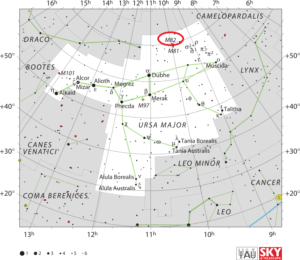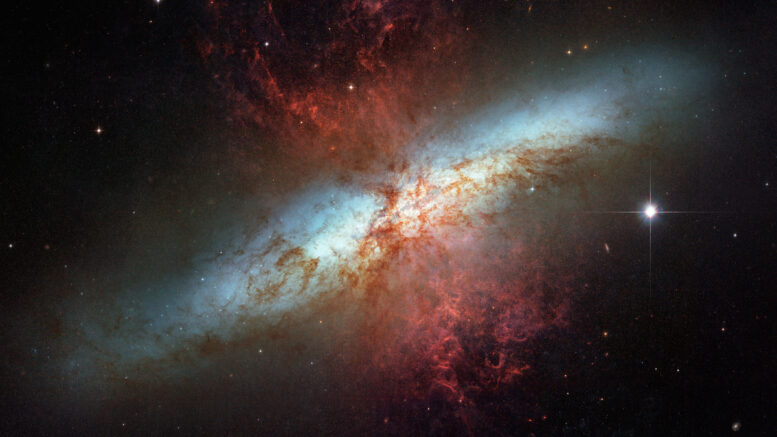Messier 82, or the Cigar galaxy, shines brightly at infrared wavelengths and is remarkable for its star formation activity. The Cigar galaxy experiences gravitational interactions with its galactic neighbor, M81, causing it to have an extraordinarily high rate of star formation — a starburst. Around the galaxy’s center, young stars are being born 10 times faster than they are inside our entire Milky Way galaxy.
| Description | |
| Visible From Pacific Northwest | March to June |
| Best Time To Observe | April |
| Minimum Size Of Viewing Device | Small Telescope |
| Object Type | Irregular Galaxy (Starburst Galaxy) |
| Designations | Messier 82, M82, NGC 3034, Cigar Galaxy, Arp 337, PGC 28655, UGC 5322, 3C 231, BWE 0951+6954, DA 277, 2E 2197, 2E 0951.7+6955, GB6 B0951+6955, IRAS 09517+6954, INTREF 396, KPG 218b, 2MASX J09555243+6940469, MCG+12-10-011, NRAO 341, NVSS J095551+694046, PRC D-13, RAFGL 1388, RBS 809, RGB J0955.9+6940, RX J095550+69406, Z 333-8, Z 0951.7+6955, SDSS J095551.73+694048.6, UT 0951+699, UZC J095557.0+694110 |
| Right Ascension | 09h 55m 52.2s |
| Declination | +69°40’47” |
| Constellation | Ursa Major |
| Number Of Stars | More Than 30 billion |
| Apparent magnitude | +8.41 |
| Apparent dimensions | 11′.2 x 4′.3 |
| Object Radius | 37,000 light years |
| Distance From Earth | 11.4 to 12.4 Million light years |
History
The Cigar Galaxy was discovered by the German astronomer Johann Elert Bode on December 31, 1774 together with the neighbouring Messier 81 (Bode’s Galaxy). Bode described the pair as “two small nebulae 3/4 degrees separated.”
The object was independently discovered by Johann Gottfried Koehler between 1772 and 1778 and later by Charles Messier’s friend and colleague Pierre Méchain in August 1779. Koehler described M81 and M82 as “two nebulous stars at the ear of the Great Bear.” Messier determined the positions for both M81 and M82 and added them to his catalogue on February 9, 1781.
William Parsons, 3rd Earl of Rosse, was the first to note the dark dust lanes in the galaxy’s central region.
Halton Arp included M82 in his Atlas of Peculiar Galaxies as Arp 337.
Locating M82 In The Sky
Messier 82 can be found about 10 degrees northwest of Dubhe, Alpha Ursae Majoris, the star that marks the northwestern corner of the Big Dipper‘s bowl. A line drawn from Phecda, Gamma Ursae Majoris, to Dubhe and extended by the same distance leads to the M81/M82 pair. M81 is located 38 arc minutes south of M82.

Viewing M82
In binoculars and small telescopes, the Cigar Galaxy appears as a thin rod of light, while 6-inch and 8-inch telescopes reveal the bright core and dark patches across the galaxy’s surface. Larger instruments show more details of the galaxy’s structure. The best time of year to observe M81 and M82 is during the spring.
In small telescopes, it forms an impressive pair with its larger neighbor, Bode’s Galaxy, M81, which appears face-on and lies only 38 arc minutes from M82.
Photographing M82
Messier 81 and Messier 82 can indeed be captured in 1 image together, even with a DSLR without a telescope. However, if this is done, one will still require autoguiding to accurately capture the image with larger exposures to get the exposure length necessary to get the details shown in the image. It is indeed possible to get these images without guidance, but that requires shorter exposures. If you want to photograph M81 and M82 using a camera and telescope, it is suggested using a focal length of at least 800mm or more. This magnification is needed to record the delicate details of each galaxy. Shorter focal lengths might see loss of detail due to the shorter focal lengths.
https://www.astrobin.com/326338/B/?nc=user
https://www.galactic-hunter.com/post/m81-m82-bode-s-galaxy-the-cigar-galaxy
Sources And Further Reading
Descriptions of all of Messier Objects can be found here.
https://www.nasa.gov/feature/goddard/2017/messier-82-the-cigar-galaxy
https://www.messier.seds.org/m/m082.html

Be the first to comment on "Messier 82 Cigar Galaxy"